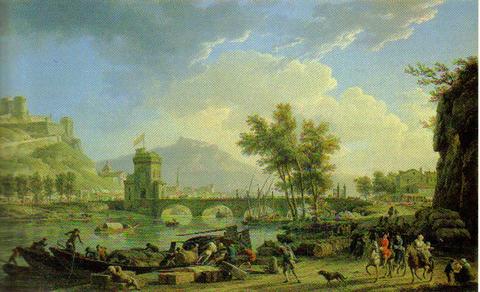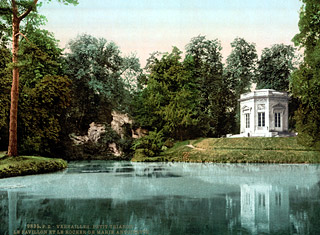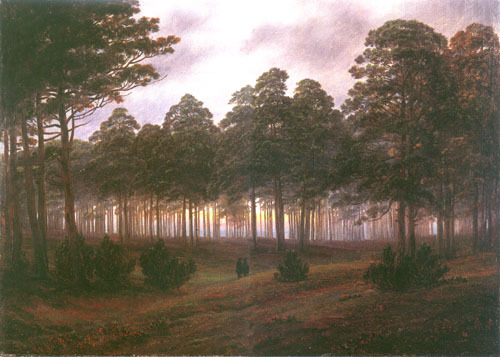Ellen and Jim Have a Blog, Too
We are two part-time academics. Ellen teaches in the English department and Jim in the IT program at George Mason University.


Women novelists, landscape through female eyes, women's friendships & letters: at Montreal · 11 April 06
Dear Marianne,
I’ve not kept my promise of telling you about the papers at Montreal that I heard, especially those on women’s art and literature. I want to do this (as I did for the sessions I heard at the recent MLA) because this process helps me remember what I heard, make sense of the papers individually, and come away with a general sense of what the meeting showed is happening among dix-huitiemistes just now. The conference showed that women are working on women’s art and literature and sensibility in greater numbers than ever despite the backlash against feminism. There were just so many sessions concentrating on women’s books that I missed things I would’ve wanted to hear since they were on in competition with others I wanted equally.
For example, on late Thursday afternoon there was a session with a paper on the Scots poet, Anne Grant, and one on Charlotte Lennox’s Euphemia but I went instead to a well-attended session whose star, Margaret Anne Doody, the moderator Jocelyn Harris, positioned last so that the first three speakers might not have the embarrassment of seeing the majority of people walk out after Doody spoke. The session was called Clarissa lives, and included papers on Sophie von La Roche’s Germany epistolary novel, The History of Lady Sophia Sternheim, on imitations of Clarissa in the first half of the 20th century (the choices seemed to reflect what book the woman knew and liked rather than books genuinely close to Richardson’s book in feel or outlook), and Doody’s own paper, "Clarissa’s legacy." Doody had intended to produce a survey of post-18th century books influenced by Clarissa, but as that would’ve been far too long for a conference paper, she talked about the will in Richardson’s novel and attitudes towards charity in novels by women and novels where the heroine is young and potentially sexually active. She made the interesting observation that only menopausal, widowed, and otherwise sexually repressed women were able to do good through charity in earlier novels; when younger women try to be charitable, their charity does them or others in.
The best thing about this set of papers was the occasional insightful sentence or information I didn’t know. Clarissa attempts control and power through her will; Burney’s Cecilia is a novel poisoned by legacies; melancholy is a drug virtue is addicted to. Doody showed how limited was the amount of charity any heroine in Austen could offer. (I thought of nonetheless women clung to small items that were theirs as a symbol of an identity and autonomy.) I didn’t know that a nasty way of interpreting Clarissa was included in a couple of the original lines of Eliot’s Wasteland, happily (for him too) excised by Pound early on.
Two sessions on landscape and women, one very late on Thursday, and the other early Friday morning were linked: in both the speakers showed how the development of landscape and lifestyles and images allowed to women were much more restrictive than those allowed men. The Thursday session, "Town & Country: Picturing Landscape in an Age of Industrialization," the first speaker showed that we can see in the paintings and poetry of the era how in the country women did not enjoy themselves in the way men did (drinking, hunting, fishing), and that a sojourn in the country was often seen as a way of controlling and/or punishing a woman (think of the later novel by Trollope, Is He Popenjoy? where the heroine is threatened with "permanent burial" in the country for having "misbehaved herself [sexually in public] in London). The virtuous ideals attached to country life worked to create stereotypes for women which were repressive. It must be said that what is shown in pictures is not necessarily how people behaved in life; nonetheless, the pictures do show how women were allowed to be seen in public and thus norms that did control their behavior.
I enjoyed the paper on Joseph-Claude Vernet (1714 – 1789) because the slides of his paintings were just so beautiful. He was commissioned to paint a series of ports undergoing "improvement;" the speaker told about the politics and conflicts between those who stood to gain from reconfiguration of landscape and those who were doing to lose place, property, a lifestyle. Vernet’s pictures bring together imaginative dream and actual applied technologies and commercial, political and social transformations in the era, as in:

Constructing a Main Road (1774)
The Friday session, "Landscape through Women’s Eyes" was the second best session I attended (the first was the one on women’s autobiography across the long 18th century). The first speaker gave an excellent paper where she compared Marie Antoinette’s garden landscape to those of exactly contemporary male aristocrats and wealthy landowners in England and France to show how landscapes controlled and shaped by a female owner were really done quite differently and tended to include different sorts of structures in the landscape. Basically men had ruins, temples, gothic and exotic structures, rustic pieces, and grottos set in a dramatically shaped landscape (chasms, hills, serpentine and intricate) with very learned schemes and figures as explanation.
By contrast women would have flatter landscapes (open fields), tame grottos, no ruins, no rushing cascades, little sublimity, and much quieter buildings with figures and allusions that were not learned but rather drawn from romance and alluding to love. She argued it was a matter of self-presentation and what was thought appropriate, respectable and safe for a woman to project. Antoinette’s garden projects the image of a chaste vestal virgin, embodying aspects of love, avoiding sensuality, innocent (drinking milk and eating milk products. The problem with the argument is she appeared not to have other landscapes she could say for sure were shaped by women, and in most cases could not tell where the owner’s taste or the landscaper’s was at work.

The Pavilion and Temple, "Le Jardin Anglais," Marie Antoinette
A wonderfully rich reading of Mary Wortley Montagu’s "Epistle to Burlington" (really to Bathurst) followed where the speaker showed the uses of landscape and meditation in a friendship poem were shaped by a woman’s point of view. It was just excellent because of the details given of Montagu’s relationship with the men in the poem, her politics, and her taste and outlook. She compared the poem to Pope’s Windsor Forest. I thought of and mentioned how in the early 17th century in Amelia Lanier’s "Description of Cookham" we have a similarly gendered use of landscape and meditation in a friendship poem.
Again I enjoyed a paper simply because the slides of paintings of the artist in question were so pleasurable: a woman spoke on the use of the figures of women in C. D. Friedrich’s sublime haunted landscapes where their dreaming thoughtful wanderers, peasant indigenous people, and dilettante tourists. In several of Friedrich’s paintings a central woman figure becomes a site where new attitudes towards nature and ironical undermining of upper class romanticisms are pictured.

C. D. Friedrich (1774-1840), Evening
The last session on Thursday was "Forgotten Epistolary Friendships." I heard a paper on the correspondence of two nuns who defied a priest set over them to produce a close friendship and record visions (Jeanne des Anges and Jeanne du Houx). One paper demonstrated how mobility was gendered in the 18th century: more men moved about freely through the increase in sailing on ships; women were influenced by the men’s movements through what they learned through books and arts (and often had a distorted idea of what life on a ship or the ocean travel was like). There was a paper on the correspondence of Manon Phlippon Roland and her two friends, Sophie and Henriette Canet.
A session on Friday, "Burney and Her French Connections" was the most dismaying of the sessions I attended. The first paper was a clearly bigoted, unfair, and misogynistic (yes) attack on Margaret Anne Doody’s book; the man’s method was to accept all the Charles Burney said were his motives for educating two of his daughters in France and not educating Fanny Burney there when the man liked these (he believed only the pragmatic); he then ridiculed motives Fanny Burney attributed to her father and castigated Doody’s interpretation of these as absurd. The second speaker defended a reader, Madame de la Fitte, at George III’s court whom it was (rightly) said Burney does not fairly represent. Burney presents Madame de la Fitte as irritating, dowdy, and embarrassingly aggressive. This speaker when she called Burney "an introvert" used the word as a condemning one, did not present any value in an introverted personality, neglected to say that Burney was hating her life in that court, and hating all that she had to endure without wanting it, and this, combined with her genuine self-directed inward personality where she was trying desperately to carve out some private space for herself was the source for much of her gut revulsion against this apparently intrusive over-demonstrative French reader.
The last two papers were on The Wanderer and Evelina. We are reading Evelina on ECW and Judy G. asked if the interpolated tramautic and violent episode about Evelina’s half-brother, MacCartney’s near suicide is "common in 18th and early 19th-century fiction?’
I replied:
"Absolutely. We have them in Austen: consider in Sense and Sensibility Colonel Brandon’s history of his thwarted love affair with his cousin, his history of Willoughby’s seduction and desertion of Brandon’s ward? consider in Persuasion Mrs Smith’s story of the treachery of Mr Elliot. In Fielding’s Tom Jones, the old man on the hill. It was the 18th century way of trying to present trauma and injustice just as it was in the 19th century.—and today too, for what is the film adaptation of Proulx’s Broke Back Mountain but emotional melodrama?
Now what happens in The Wanderer is Burney attempts to make such a story the center of her narrative. She conceives herself as making conservative points so the suicide is one Elinor Jonquil (so some such name) who is a Mary Wollstonecraft character and for her pains she is made miserable and attempts suicide. In Cecilia we have a central suicide too: like Trollope it’s a man who is so in debt that he’s about to be publicly undone and shamed and he can’t face it. Frances Sheridan’s Sidney Biddulph makes such a melodrama it’s center: debt, misery, mindless emulation of common mores, and sexual betrayal too, as well as a marriage made by a mother for her daughter which destroys any chance for fulfillment this daughter could have had.
The third paper in "Burney and Her French Connections" was on the attempted suicide by Elinor Jonquil in The Wanderer; the speaker tried to connect this near suicide to Germaine de Stael’s thoughts on suicide from a feminist perspective, but as the language was so abstract I became lost and didn’t really get the connections. What was brought home to me is how frequently suicide is a motif in Burney. A long sequence in Camilla has a central female going mad and wanting to die. I wish this speaker had brought in Burney’s tragedies and in understandable English connected the troubles of Burney’s own life and traumatic incidents in her diaries to what we find in The Wanderer and the other near-suicide stories in Burne’s novels.
The fourth paper on Evelina was an attempt to deal with the art of Evelina, and it was sort of thing I’ve come across more than once: a back-handed defense of the cruel slapstick and antics of the book. The way this is done is find modern themes in the scene, and then present the scene as funny without analyzing the source of the actual humor. Then if you say you don’t find it funny you are both ignoring what is being defended (modern themes) and implicitly a prig. In this one the person analyzed a later monkey scene where the crash Lovell is terrified and the Captain plays a major role. She showed how the conventions of dancing are used in Evelina to position the characters. I didn’t quite see how this connected to the antics of the monkey scene myself. This later monkey scene does has interest because the monkey and the monkey is meant to be a sort of parody of humankind. It leaves you wondering how much Burney knew of libertine thought—which sometimes played with proto-evolutionary ideas. For Burney maybe it was she was half-remembering Swift’s Yahoos? It also does throw back across the book another perspective which is psychoanalytic in a way and also anthropological.
I have one more report to send on: on sessions which included papers on women painters, on what is found in plays by and about women, on women’s educational writing and treatises in the era; on apparent sensational non-fiction (the anonymous book called The History of the Penitents in the Magdalen House), and on the women writers who made the transition from later 18th century subversive to early 19th century pious and conservative writers. These topics were also canvassed intelligently and informatively at Montreal.
But as it’s past midnight, this must be in another late night session, Marianne,
Elinor
--
Posted by: Ellen
* * *
Comment
commenting closed for this article
